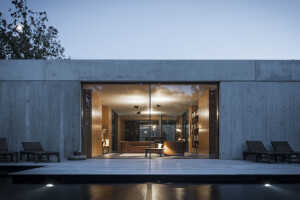Expansion & Renovation of the main library
Approaching the design of the new Haifa university campus in a site overlooking the port town from the top of the Carmel ridge, Niemeyer stated: ”The overwhelming beauty of the site clearly calls for a compact solution, simple but monumental”.
Niemeyer’s design was in direct opposition to the conventional typology of the campus. His proposal was a condensation its dispersed layout into a single structure designed to accommodate all programs under a single, giant roof. Public passages and halls were laid out in order to differentiate programs from one another and act as meeting places for the campus dwellers. In this unique university, collecting students from all over the north of the Israel and creating a mixed racial (60% Jew/Arab 40%) body of students, Niemeyer’s vision of an “Inter-disciplinary plural academism of maximum interaction” could be best implemented…..*. In the 35 years that have passed since the library’s opening the building witnessed many changes. Its 270m long by 70m wide, open plan, has been repeatedly changed as the building served an ever-increasing number of students and staff. As a result the fluent open spaces that were its key feature, have been compressed by endless ill planned partitions.
The competitions brief demanded a solution for the problem of crowdedness. It included a detailed program for an additional building that would accommodate the library’s staff. It also specified (without location) the library’s need for a “central core” as a diverse information space and a place for encounter between students and staff.
* Z. Elhyani – “Oscar Niemeyer and the outset of speculative urbanism in Israel after 1960” The proposal uses the brief in-order to initiate a constructive process of critique. Both “ends” of the building; the rigid romantics of the original plan, as well as the chaotic maze of its current un-plan, are analyzed in order to articulate an intervention capable of generating a parallel shift. The proposal is developed from within in-order to create an interactive relationship between interior and exterior and aims to offer diversity rather than to force dialog. It seeks to dissolve the boundary between in & out and generate a shift in the spatial hierarchy of the deep structure and its single transparent façade. It does so by claiming two adjacent un-used exterior spaces for the use of the library: the open patio and the roof.












































